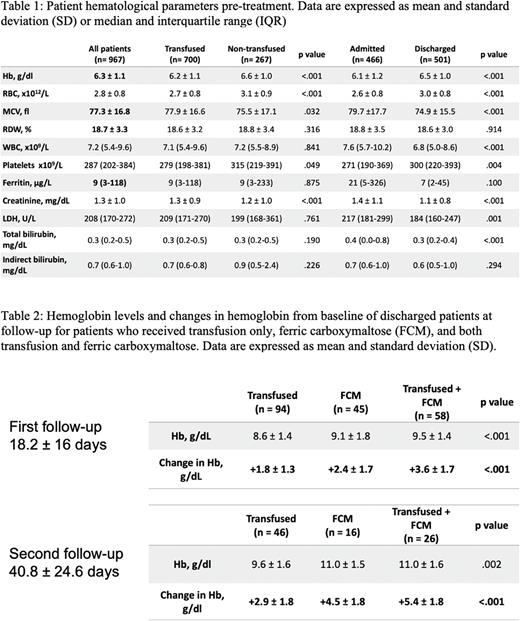Abstract
Background: Despite the implementation of the Choosing Wisely Campaign of the AABB (formerly the American Association of Blood Banks), red blood cell (RBC) transfusions continue to be a common choice of treatment for iron deficiency anemia (IDA) in hemodynamically stable patients presenting to the emergency department (ED). This occurs despite the considerable risk and high cost of RBC transfusions and the availability of alternative treatments with robust safety profiles such as intravenous (IV) iron. An understanding of the patient clinical factors that affect the decision to transfuse is essential to narrowing the gap between clinical guidelines and current clinical practice, and to ensuring appropriate RBC usage.
Aims and methods: To assess the clinical management of severely anemic, hemodynamically stable patients presenting to the ED, we performed an observational, retrospective study at a tertiary care hospital in Milan, Italy, over a five-year period from 2017 through 2021. Only patients with severe anemia (i.e., hemoglobin < 8 g/dL) were included. Patients with conditions for which transfusion is the first-line treatment, including hemoglobinopathies and active onco-hematological disorders, were excluded.
Results: 967 patients were included in the study. The population was 63% female with a median age of 77 years (IQR, 61-85). Hematological parameters (Table 1) characterized the study population as microcytic, with high red cell distribution width (RDW) and, when available, low ferritin values, indicative of a significant role of iron deficiency anemia within the population. 72% of patients (n=700) received a transfusion in the ED. 20% (n=189) received both transfusion and IV iron, 11% (n=108) IV iron only, and 16% (n=159) received neither transfusion nor intravenous iron. Half of the subjects presented to the ED with symptoms, largely with asthenia and exertional dyspnea, while severe symptoms (palpitations, syncope, chest pain) were present in less than 4% of patients. Gastrointestinal bleeding (33%, n=319) was the most common known cause of anemia, followed by gynecological bleeding (6%, n=56).
For data analysis, patients were divided into two treatment groups (transfused (T) vs. non-transfused (NT)) and two outcome groups (discharged (D) vs. admitted (A)). Patients with documented heavy gynecological bleeding were more represented in the transfused group and the discharged group (T:3.7% vs NT:11.2%; D:0.8% vs A:10.3%; p<.001). Similarly, patients with malabsorptive diagnoses (e.g. celiac disease, inflammatory bowel disease, bariatric surgery) were more prevalent among those discharged (A:1% vs D:3.1% p=.027). Patients with cardiovascular disease were more represented among those transfused (T:42.3% vs NT:24.3%, p<.001) and among those admitted (A:42.4% vs D:32.7%, p=.002). Diabetic patients were likewise more prevalent among those transfused (T:17.8% vs NT:11.2%, p=.012) and those admitted (A:18.8% vs 13.3%, p=.020). Patients on antithrombotic therapies were more represented in the transfused (T:49.7% vs NT:27.7%, p<.001) and admitted (A:48% vs D:39.5%, p=.008) groups. Discharged patients who received IV iron in the ED saw significantly higher increases in hemoglobin levels at an initial (mean 18 days post-discharge) and second (mean 41 days) follow-up (Table 2). Transfused patients spent a mean 12.8 hours longer in the ED than those who were not transfused, demonstrative of a significantly higher utilization of ED resources in the administration of red blood cells.
Conclusions: Our study demonstrated a high usage of red blood cell transfusions to treat anemia in the ED. Overall, transfused patients were older, with a higher prevalence of cardiovascular disease and diabetes and anticoagulant or antiaggregant therapy. It seems probable that these characteristics could have influenced the physician in the decision to transfuse. IV iron preparations were demonstrated to not only be effective in managing severe iron deficiency anemia in the ED but also more efficacious in the long-term correction of anemia.
Our study overall demonstrated a continued knowledge-to-practice gap in the management of severe anemia in the emergency department.
Disclosures
Cappellini:Sanofi genzyme: Consultancy, Speakers Bureau; BMS: Consultancy, Speakers Bureau; Vifor: Consultancy, Membership on an entity's Board of Directors or advisory committees; vertex: Membership on an entity's Board of Directors or advisory committees; Agios: Membership on an entity's Board of Directors or advisory committees. Motta:Sanofi Genzyme: Consultancy, Honoraria, Membership on an entity's Board of Directors or advisory committees; Bristol Myers Squibb: Membership on an entity's Board of Directors or advisory committees; Amicus Therapeutics: Membership on an entity's Board of Directors or advisory committees.
Author notes
Asterisk with author names denotes non-ASH members.


This feature is available to Subscribers Only
Sign In or Create an Account Close Modal